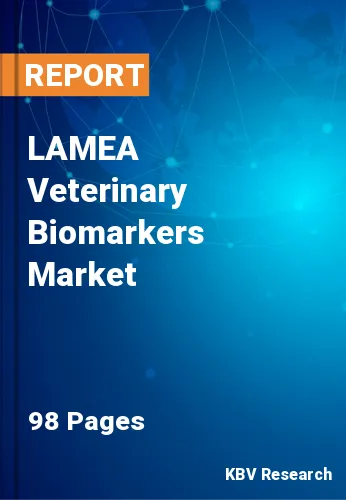The Latin America, Middle East and Africa Veterinary Biomarkers Market would witness market growth of 18.1% CAGR during the forecast period (2022-2028).
The key market players are introducing cutting-edge biomarker-based solutions to strengthen their position as the industry's leaders. For instance, Zoetis introduced the Stablelab hand-held biomarker reader to detect the serum amyloid a biomarker for equine inflammatory disorders. This expansion can be attributed to rising animal healthcare costs and disposable money in important markets, as well as growing biomarker awareness in veterinary clinics.
The rising love for animals is also contributing to the greater use of biomarkers. People's moods are improved by having animals around them, especially those who are struggling with disorders themselves. Additionally, it has been demonstrated to lower blood pressure, enhance cardiovascular health, and decrease the number of drugs certain people need. Also, it causes the release of other hormones, including phenylethylamine, which has a similar impact to chocolate. The market for veterinary biomarkers is expanding as a result of the rising need for accurate and quick diagnoses of many diseases as well as pet humanization.
Chile is the Latin American nation with the highest per-capita ownership of dogs. Because more young Latino adults are choosing to live alone, choose pets as a company, and put off marriage due to rising salaries, more of these individuals can now regard dogs as part of the family. However, there is still space for growth in Latin America, as roughly 75 percent of Mexican dogs consume burrito leftovers. Advertising campaigns, such as those seen on park billboards in Mexico City, exhort pet owners to convert to packaged, name-brand pet foods.
The Brazil market dominated the LAMEA Veterinary Biomarkers Market by Country in 2021, and would continue to be a dominant market till 2028; thereby, achieving a market value of $32.8 million by 2028. The Argentina market is experiencing a CAGR of 18.8% during (2022 - 2028). Additionally, The UAE market would display a CAGR of 17.8% during (2022 - 2028).
Based on Animal Type, the market is segmented into Companion (Dogs, Cats, and Others) and Production. Based on Disease Type, the market is segmented into Inflammatory & Infectious Diseases, Turf & Landscaping, Tumor, Skeletal Muscle Diseases, and Others. Based on Product Type, the market is segmented into Biomarkers, Kits & Reagents and Biomarker Readers. Based on Application, the market is segmented into Disease Diagnostics, Preclinical Research, and Others. Based on countries, the market is segmented into Brazil, Argentina, UAE, Saudi Arabia, South Africa, Nigeria, and Rest of LAMEA.
Free Valuable Insights: The Global Veterinary Biomarkers Market is Predict to reach $1.5 Billion by 2028, at a CAGR of 11.7%
The market research report covers the analysis of key stake holders of the market. Key companies profiled in the report include Zoetis, Inc., Merck & Co., Inc., Virbac, IDEXX Laboratories, Inc., MI:RNA Diagnostics Ltd., Mercodia AB, Antech Diagnostics, Inc. (Mars, Inc.), Avacta Animal Health Limited (Vimian Group), Life Diagnostics, Inc., and Acuvet Biotech.
By Animal Type
By Disease Type
By Product Type
By Application
By Country
Our team of dedicated experts can provide you with attractive expansion opportunities for your business.

